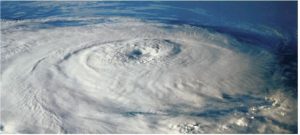
According to the National Weather Service, the U.S. hurricane and tropical storm season begins May 15 in the Pacific region and June 1 in the Atlantic region. It runs through the end of November, with the most destructive storms occurring August through October.
Pre-hurricane preparation
Secure supplies and information
- Maintain a current list of telephone numbers and contacts for emergency action team members, emergency management (civil defense), local police and fire departments, medical facilities, utilities, contractors, vendors, insurance agent/broker, building owner, HVAC contractor, electrician, plumber, etc.Contact local authorities to help plan and coordinate activities before the need for emergency action.
- Designate a person to monitor weather conditions and keep the Emergency Action Plan leader up to date before, during, and after a hurricane.
- Arrange backup communications, such as two-way radios or cell phones.
- Arrange an off-site emergency communications control center, such as a hotel meeting room just outside the hurricane area, in case it becomes too dangerous to remain on site.
- Review your Business Continuity Plan and update as needed, including employee contact information.
- Remind employees of key elements of your Business Continuity Plan, such as:
- Communicating post-event procedures and work/payroll procedures
- Making sure all employees have a paper copy of the plan
- Ensuring that post-event communications procedures discuss how employees will be notified when they can return to work (local radio or TV station public service announcement, telephone call, employee intranet, etc.)
- Inspect all fire protection and life safety equipment.
- Provide diesel or gasoline-driven emergency generator on site with full tank of fuel and reserve fuel on hand. (High demand may make it difficult to obtain a generator. Advance arrangements and/or retainers may ensure availability.)
- Determine which company records are vital and make plans to protect/relocate them.
- Identify vulnerable and/or critical equipment and processes. Provide instructions for safely shutting down processes, data processing equipment, etc. Consider disconnecting and relocating critical equipment to higher elevations.
- Identify stock that needs to be protected with tarpaulins or waterproof covers.
- Identify a hot site (an off-site data processing location for immediate business resumption) or a cold site (an off-site location ready for setup of your own data processing equipment). Consider an off-site business recovery facility where you can resume general business operations.
- Identify actions to take in the event of live electrical wires, leaking gas, flammable liquids, corrosive/toxic materials, and damage to foundations or underground piping.
- Evaluate the interdependency of your facilities and develop a contingency plan.
- Maintain ongoing agreements with contractors for supplies and repairs needed after the hurricane. When possible, use contractors who are outside potential hurricane areas, as local contractors may also have storm damage or local authorities’ needs may be given a higher priority.
- Maintain emergency supplies throughout the season, such as drinking water, nonperishable food, medical supplies, flashlights, batteries, walkie-talkies, portable pumps, hose, emergency lighting, lumber, plywood, nails, hand and power tools, plastic covers and tarpaulins, etc.
- Maintain straps or other means to brace/anchor yard storage, signs, cranes, and roof-mounted equipment.
- Inspect and repair roof flashings, coverings, drains, gutters, and edge strips. Remove debris and unrestrained materials from roofs.
- Inspect and maintain signs, stacks, and tower supports, guy wires, and anchor points.
- Repair or replace loose or worn door and window latches, hardware, and seals.
- Check all exterior windows and doors for openings or cracks and use silicon caulk to seal and cracks, gaps, or holes. This includes wall mounted air conditioning units which tend to allow water to enter around or through the unit.
- Provide refitted hurricane shutters and/or plywood for windows and doorways where practical. If possible, install them in advance and leave them in place for the entire season.
- Prepare for flooding with sandbags and a supply of brooms, mops, squeegees, and other absorbents to help remove water.
- Trim or remove large trees that could fall and damage buildings or impair fire protection or electrical power and communication lines, etc.
- Arrange for site security for after the hurricane.
- Prepare a space inside for storing dumpsters, yard equipment, and yard stock.
- Evaluate safe approaches to your facility for emergency access and when employees return to work.
- Establish priority/backup personnel or rotation personnel for critical operations and/or processes. Employees may have personal emergencies and may or may not be available to return to work promptly.

Emergency kit
- First aid kit: Include prescription medications, over-the-counter painkillers, rubbing alcohol, eye wash kit, and vomit-inducing medicine in case of accidental poisoning
- Emergency lighting: flashlights, lanterns, extra batteries
- Battery or crank-powered radio
- Two-way radios or cell phones (with spare batteries)
- Plastic covers and tarpaulins
- Two-week supply of drinking water and nonperishable food
- Medical supplies/first-aid kits
- Whistles to signal and direct attention during and after a hurricane
- Portable pumps and hose
- Lumber, plywood, nails
- Hand and power tools
- Blankets and extra clothing
- Impending hurricane preparation
- Inspect and fortify your facility
- Monitor and map the hurricane to keep current on its progress.
- Implement the Emergency Action Plan. Take specific actions at the predetermined times as outlined in the plan.
- Shut down operations that depend on outside power sources in an orderly manner, following established procedures.
- Shut down gas-fired equipment and shut off main gas valves.
- Shut down all noncritical and nonessential electrical equipment.
- Disconnect the main electrical feeds to the facility, if possible.
- Ensure Emergency Kit supplies and equipment are on hand and ready for the on-site Emergency Action Team.
- Obtain cash for post-hurricane needs such as buying food and supplies or paying employees and contractors.
- Protect and/or relocate vital records off site. Include blueprints, structural records, utility plans.
- Relocate water-sensitive equipment and materials to safe areas away from exterior doors and windows and off the floor.
- De-energize and cover computers, machinery, and stock with tarpaulins and waterproof covers.
- Isolate or remove any chemicals that can react violently with each other.
- Check and clear floor drains.
- Inspect and make repairs to roof drains, gutters, and flashing.
- Secure roof-mounted equipment such as HVAC units and exhaust vents.
- Check guy wires on antennas, stacks, and towers.
- Remove TV and radio antennas and satellite dishes from the roof.
- Remove unrestrained materials from the roof.
- Close and latch exterior doors, windows, and roof hatches. Close ALL interior doors as well.
- Install hurricane shutters/plywood over doors and all windows.
- Clean out storm drains, culverts, and catch basins.
- Fill all aboveground and underground tanks with product or water.
- Verify that all fire protection equipment is in service.
- Check/maintain all necessary backup equipment, such as emergency generators and communication systems/devices.
- Fill the fuel tanks of generators, fire pumps, and all company-owned vehicles.
- Conduct a yard inspection for unrestrained materials, specifically:
- Remove loose yard debris.
- Relocate nonessential yard equipment to a safe indoor location (furniture, trash receptacles, portable planters, portable signs, dumpsters, etc.).
- Relocate yard storage of raw and finished goods indoors or secure.
- Secure yard storage of flammable liquids drums or move them to a safe location away from important buildings.
- Anchor all portable buildings and trailers to the ground.
- Secure scaffolds and cranes. Secure scaffolds to the building.
- Fasten rail crane chassis to track with bolts and clamps.
- Brace outdoor signs.
- Notify key customers, suppliers, and partners of office/facility closing and contingency plans.
- Make decisions on when to excuse employees so that they have sufficient time to prepare their homes and families.
- Customize messages for business website, telephone recording, employee intranet, etc.
During the hurricane
- Emergency personnel should stay at the facility only if safe to do so. Notify local authorities if personnel are staying on site.
- Keep names and phone numbers of electrician, heating contractor, plumber, fire department, and building owner easily accessible.
- Comply with all directions provided by authorities.
- Keep first-aid kit available.
- Designate times for key staff members to call in for situation updates.
- Update employee emergency hotline and/or company intranet and website with posting on the status of the facility.
- When safe to do so, patrol the property continuously. Watch for roof leaks, pipe breakage, fire, or structural damage.
- Constantly monitor any boilers that must remain online.
- During power failure, turn off electrical switches to prevent re-energizing of equipment until necessary checks are completed.
Post-hurricane procedures
Immediate actions
The devastation a hurricane leaves in its wake depends on the location, population density, and hurricane size. In the immediate aftermath of a hurricane, it is important to quickly and calmly assess the situation.
- Do not move seriously injured individuals. If high-rise buildings are in the general area, falling debris may make open areas more dangerous than remaining inside the buildings. Watch out for fallen power lines and broken gas lines.
- Provide search and rescue personnel with last known location of any missing victim(s).
- Secure the site and provide watch service if necessary.
- Visually check for open bus bars, conductors, and exposed insulators before re-energizing electrical systems.
Recovery actions
- Look for safety hazards such as live electrical wires, leaking gas, flammable liquids, corrosive/toxic materials, and damage to foundations or underground piping.
- Repair automatic sprinkler protection and/or water supplies to get protection back in service as soon as possible. Use Liberty Mutual Fire Protection Impairment Procedures whenever sprinkler protection and/or water supplies are impaired. Contact Liberty Mutual at 800541-5224 to report impairments to fire protection systems or for assistance in restoring systems.
- Conduct two-inch main drain and alarm tests on automatic fire protection sprinkler systems to verify public water supply availability.
- Control smoking and use Hot Work Permits where applicable. Maintain fire-safe conditions at all times.
- Contact key personnel and notify contractors to start repairs.
- Begin salvage as soon as possible to prevent further damage:
- Cover broken windows and torn roof coverings immediately.
- Separate damaged goods.
- Clean roof drains and remove debris from roofs.
- Limit access to freezers and refrigerated areas during periods of interrupted electrical service to maintain the temperatures as long as possible.
- Check refrigerated items for spoilage if there has been a power failure.
- Notify key customers, suppliers, and partners of office/facility reopening and any necessary property or operational changes resulting from storm damage.
- Debrief on the successes and shortcomings of your Emergency Action Plan. Compile a log of actions to be taken and incorporate improvements.
Hurricane information and important terms
Beyond preparing your property, it is important to stay informed and understand the hurricane terminology. By international agreement, all cyclone circulation originating over tropical waters are referred to as “tropical cyclones” and classified by form and intensity as follows:
- Tropical disturbance: A moving area of thunderstorms in the tropics that maintains its identity for 24 hours or more.
- Tropical depression: Rotary circulation at the surface, maximum sustained highest constant wind speed 38 miles per hour (33 knots).
- Tropical storm: Distinct rotary circulation, maximum sustained constant wind speed ranges from 39 – 73 miles per hour (34 – 63 knots).
- Hurricane: A tropical cyclone with winds of maximum sustained 74 miles per hour or greater that is usually accompanied by heavy rain, thunder, lighting, coastal tidal surges, and possible tornadoes. These storms are also known as typhoons in the Western Pacific and cyclones in the Indian Ocean and South Pacific Ocean around Australia.
- Hurricane watch: Issued for a coastal area where there is a threat of hurricane conditions within 24 – 36 hours.
- Hurricane warning: Issued when hurricane conditions are expected in a specified coastal area within 24 hours or less. Actions for protection of life and property should begin immediately.
- Flash flood watch: A flash flood is possible in the area. Stay alert.
- Flash flood warning: A flash flood is imminent. Take immediate action.
What to expect
Pay close attention to terminology when reviewing weather forecasts. There is a distinct difference between “sustained” wind speeds and “gust” wind speeds. Sustained wind speeds are based on an average wind speed over a one-minute duration. Gust wind speeds are based on a maximum wind speed over a 3-second duration.
Most damage is caused by gust vs. sustained wind speeds.
Saffir-Simpson Hurricane Scale is a measurement scale of hurricane wind and ocean surge intensity ranging from 1 to 5. Category 1 is a weak hurricane and Category 5 is the most intense.
The Saffir-Simpson Classification System for Hurricanes
Updated based on American Society of Civil Engineers (ASCE) 7 guidance.
Category 1— Light damage
| Sustained wind speeds | Three-second gust wind speeds | Storm surge |
| 74 – 95 mph (33.1- 42.5 m/s) | 82 -108 mph (36.7 – 48.3 m/s) | 4 – 5 ft.
(1.2-1.5 m) |
Category 2 — Moderate damage
| Sustained wind speeds | Three-second gust wind speeds | Storm surge |
| 96 -110 mph (42.6 – 49.2 m/s) | 109 -130 mph (48.4 – 58.1 m/s) | 6 – 8 ft.
(1.8-2.4 m) |
Category 3 — Extensive damage
| Sustained wind speeds | Three-second gust wind speeds | Storm surge |
| 111-130 mph (49.3 – 58.1 m/s) | 131-156 mph (58.2 – 69.7 m/s) | 9 -12 ft.
(2.7-3.6 m) |
Category 4 — Extreme damage
| Sustained wind speeds | Three-second gust wind speeds | Storm surge |
| 131-155 mph (58.2 – 69.3 m/s) | 157 -191mph (69.8 – 85.4 m/s) | 13 -18 ft.
(4-5.5 m) |
Category 5 — Catastrophic damage
| Sustained wind speeds | Three-second gust wind speeds | Storm surge |
| >155 mph (>69.3 m/s) | >191 mph (>85.4 m/s) | >18
(>5.5 m) |
- Category 1: Very dangerous winds will produce some damage. Well-constructed frame homes could have damage to roof, shingles, vinyl siding, and gutters. Large branches of trees will snap and shallowly rooted trees may be toppled. Extensive damage to power lines and poles likely will result in power outages that could last a few to several days.
- Category 2: Extremely dangerous winds will cause extensive damage. Well-constructed frame homes could sustain major roof and siding damage. Many shallowly rooted trees will be snapped or uprooted and numerous roads will be blocked. Near-total power loss is expected with outages that could last from several days to weeks.
- Category 3: Devastating damage will occur. Well-built framed homes may incur major damage or removal of roof decking and gable ends. Many trees will be snapped or uprooted, blocking numerous roads. Electricity and water will be unavailable for several days to weeks after the storm passes.
- Category 4: Catastrophic damage will occur. Well-built framed homes can sustain severe damage with loss of most of the roof structure and/or some exterior walls. Most trees will be snapped or uprooted and power poles downed. Fallen trees and power poles will isolate residential areas. Power outages will last weeks to possibly months. Most of the area will be uninhabitable for weeks or months.
- Category 5: Catastrophic damage will occur. A high percentage of framed homes will be destroyed, with total roof failure and wall collapse. Fallen trees and power poles will isolate residential areas. Power outages will last for weeks to possibly months. Most of the area will be uninhabitable for weeks or months.
Additional resources

Find out what is different about us today:
Text or call: 318-336-5202
Email reed@reedinsla.com
You can meet our team HERE
You can start a quote HERE
We’ll be glad to take a look at your insurance coverage in any of the states of Louisiana, Texas, Arkansas, and Mississippi.
Thank you,
Beaux Pilgrim, CEO

Reed Insurance
